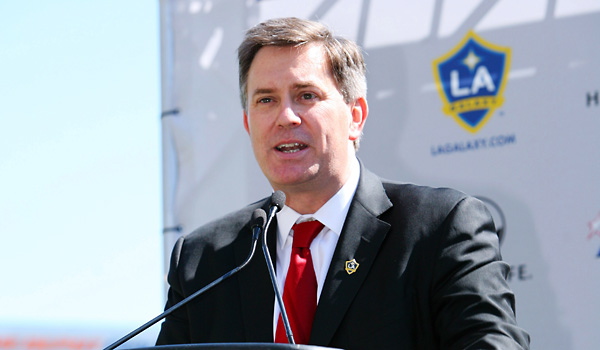The Future Of AEG's Farmers Field
Why doesn’t America’s second-largest city have a football team?
This question has plagued Angelenos for years, and the answer isn't simple.
In 2010, Anshultz Entertainment Group (AEG), under the direction of then-President and CEO Tim Leiweke, embarked on its second attempt to construct a football stadium in downtown Los Angeles.
AEG, which also manages the land containing the Staples Center and L.A. Live, unveiled plans for a 72,000-seat, retractable-roofed structure for the 15-acre property, where the West Hall of the Los Angeles Convention Center currently stands.
And in February 2011, Farmers Insurance signed a 30-year, $700-million contract for the right to put its name on the unbuilt stadium.
READ MORE: "Why Small Boutiques Are Setting Up Shop In Downtown L.A."
Everything looked good until a major fumble in foresight.
"It’s hard to see Farmers Field being constructed without an agreement to bring an NFL team to Los Angeles first," says David Carter, a professor in sports business at USC.
Most NFL teams are unwilling to relocate, and others aren't in the market for a new stadium just yet. The earliest potential buyers are the St. Louis Rams and the Oakland Raiders, both whose current leases expire after the 2014 season. For the Rams, their move to Los Angeles might happen given owner Stan Kroenke's recent purchase of a stadium-sized property in Inglewood, Calif., but that would mean L.A. football fans would have to trek west to catch a game.
And if either team makes Farmers Field its home, construction wouldn't begin until 2015 at the earliest.
Game-changer Casey Wasserman, CEO of Wasserman Media Group (WMG), a sports marketing and talent management company, could be just what Los Angeles needs to accelerate Farmers Field's plans.
“Because Casey Wasserman is involved as a potential part of the ownership team, whoever gets a deal in place, they would probably have Wasserman as part of their team," says Jeff Fellenzer, a USC Sports Media professor.
Fellenzer prefers AEG's plan in downtown because of his confidence in Wasserman, who also owns Los Angeles' arena football team, the Avengers.

“You can’t expect the next person will have that same ability as Leiweke,” Fellenzer says.
It’s likely that a major reason for Leiweke's departure is due to the attempted and failed sale of AEG. Fellenzer guesses there were “limited buyers and a limited market, as not many people would be willing to make that investment for such an expensive company.” He also feels that the acquisition of an NFL team “was never [AEG owner Phillip] Anschutz’s highest priority, as a lot of commitment is needed” for this project. Reports also came out that said “Anschutz got wind that Leiweke was trying to influence the choice of a buyer for AEG" and that "Anschutz became infuriated and fired him and ended the sale.”
Negotiations with the NFL could be easier without Leiweke acting as a middle man, and head honcho Anschutz might now be free to become more directly and efficiently involved.
Farmers Field's website printed the following statement: “AEG remains firmly committed to building Farmers Field and bringing the NFL back to Los Angeles according to its Chairman Philip Anschutz who late last week announced that the organization was no longer for sale and that he would be resuming a more active role in the company.”
But even if Los Angeles succeeds in attracting a football team, there's the little thing of transportation.
It’s no secret one of the looming issues with building a football stadium in downtown Los Angeles is the task of efficiently transporting 70,000+ fans to and from the already congested area. The NFL’s smallest stadium, CenturyLink Field in Seattle, rests on 30 acres. Farmers Field, which only holds 15 acres, would need significant surrounding infrastructure to accommodate parking for all its guests or provide adequate public transit. For the most recent Super Bowl in New Jersey, attendees were forced to stand for hours in the cold before and after the game while waiting for an available train.
With NFL ticket sales already declining — the Bengals, the Colts and the Green Bay Packers all struggled to sell playoff tickets this year — how many fans would bear traffic to watch an NFL game they can see on TV?
Los Angeles has the economy to support an NFL team, but downtown might not be the best place for a stadium. The situation is foggy, and it’ll take a different kind of quarterback — someone like Anschutz or Wasserman — to lead this multi-billion dollar effort to get the NFL back in Los Angeles for the foreseeable future.
But don't despair.
"There isn’t any indication [the Farmers Field plan] isn’t still viable,” Fellenzer says.
This story is part of a Neon Tommy special on the revitalization of downtown Los Angeles. Click #reviveDTLA for more.
Reach Staff Reporter Andrew McKagan here.



